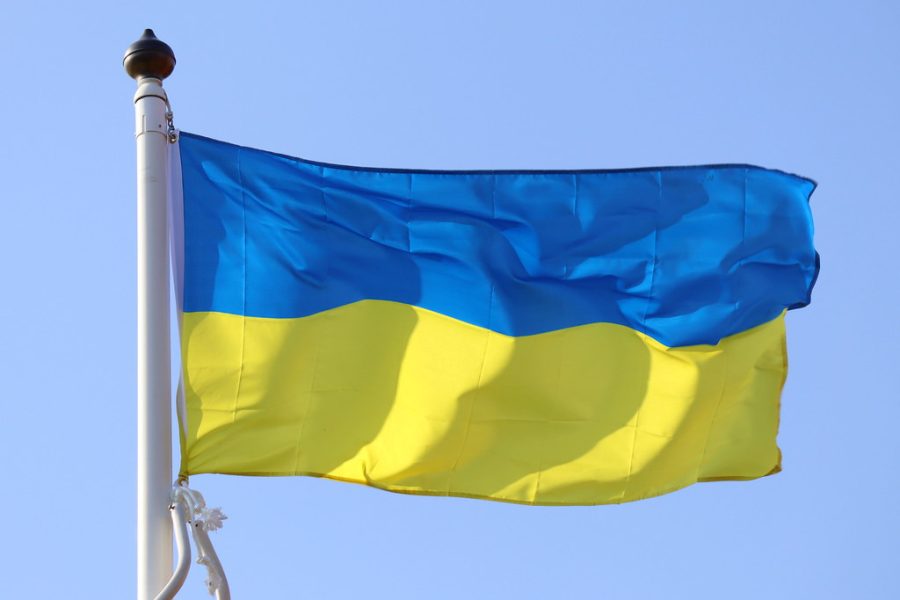Looking back at Russia’s war on Ukraine
May 18, 2023
Editor’s note: This story contains in-depth information on the war in Ukraine and mentions torture, killings, and mass casualties. Spilled Ink wishes to share the stories we think are important to provide a voice for the voiceless and share information on a major world event currently happening.
In Ukraine, young children, teenagers, adults, and the elderly have been tortured, injured, killed, and forced out of their homes and country. It is a horror millions in Ukraine face daily.
On Feb. 24, 2022, Russian military forces invaded Ukraine to dismantle Ukraine’s democratic government and install a puppet regime. This act has resulted in the death or injury of hundreds of thousands of people and disrupted the lives of millions.
Vladimir Putin, the president of the Russian Federation, justified the invasion through unsubstantiated claims stating, “We will seek to demilitarize and denazify Ukraine, as well as bring to trial those who perpetrated numerous bloody crimes against civilians, including against citizens of the Russian Federation”
Several nations have condemned Russia’s action as a violation of international law for traumatizing, injuring, and killing hundreds of thousands of civilians, the same individuals Putin purports to be saving. Leaders across the world have stood up against Russia and provided support because of these actions.
Many countries have opened their borders to the waves of Ukrainian refugees trying to escape the battlefield their homes had become. Poland alone has allowed more than 11.1 million Ukrainians to cross its borders, and many other countries also are permitting sanctuary and giving aid. As the war continues, many countries have sent supplies, accepted refugees, and provided military assistance to Ukraine. NATO and the countries involved have been Ukraine’s biggest allies. However, despite this aid, Ukraine is alone on the front lines and in direct opposition to Russia.
“While Ukraine is not as big as the US, it is the biggest country in Europe and a democratic country. We have been fighting for our freedom, and we are a liberal country,” former Lambkin Hanna Khmelovska, who was an exchange student from Ukraine, said. “We have a university program called European Studies which allows graduates to work in the government trying to join the EU. The fact that such a country in Europe can be invaded in 2022, and the world doesn’t send any troops, says that it is OK to invade other countries.”
The International Committee of the Red Cross and Henry Dunant, a Swiss humanitarian, established the International Humanitarian Laws to protect the life, liberty, and dignity of civilians not actively fighting. Throughout the war in Ukraine, Russia has repeatedly broken the primary rules that govern armed conflict.
Rule 1 states that attacks must be directed against combatants, and soldiers are not allowed to attack civilians. Rule 7 states that civilian objects cannot be directly attacked. Lastly, rule 11 states indiscriminate attacks are prohibited. These are rules that the Nazis consistently disobeyed and are now rules that Russia has disregarded.
For instance, on Oct. 10, 2022, Russia launched ballistic missile strikes on Kyiv, Lviv, and other Ukrainian cities targeting the country’s electrical infrastructure. These missiles were not precision-guided, killing at least 14 civilians and injuring 97 others. These strikes occur daily in Ukraine, destroying non-military targets and spreading terror through the civilian population. Another example is the July 27 bombing of the Kremenchuk mall, which left 21 people dead, 56 more injured, and many searching for lost friends and family.
At the beginning of the war, Putin urged Ukrainian soldiers “to lay down your weapons immediately and go home.” He went on to say, “I want to make clear that all servicemen of the Ukrainian army who do so will be able to freely leave the combat zone and return to their families.”
What Russia did to the town of Bucha directly opposes Putin’s promises, and the hundreds left dead despite not fighting are key evidence against his words. In Bucha, mass graves filled with dead bodies were found. People were left pleading with Russian soldiers for the right to retrieve the bodies of their friends and families and dig their graves. An example,Tetiana Ustymenko, a 65-year-old woman, was forced to bury her son and his friends in her front garden alone.
Many, however, were left decomposing on the street, with families unable to reach them. Yablonska Street, or “The Street of Death,” as it was called due to the numerous bodies, Russian tanks, and destroyed vehicles along it, was the resting place for many of these innocents until Ukrainian forces liberated them. One by one, those fleeing, shopping, and sheltering at home were maimed, tortured, and killed, with many being left to die. After the liberation, when the atrocities were shown to the soldiers and the world, an investigation was launched to hold the attackers responsible for their crimes.
According to the New York Times, which sifted through all the footage during the occupation, the paratroopers of the 234 led by Colonel Artyom “Uran” Gorodilov were responsible for most of the crimes committed during the invasion of Bucha. These deaths were committed due to a “cleansing operation” in an attempt to reach Kyiv. The Nazis performed a similar cleansing operation during WWII, an opponent Russia fought against. In Bucha alone, there are thousands of stories of torture, rape, murder, and indiscriminate killings of people of all ages. Children under the age of ten were killed for no other reason than being Ukrainian, and people all across the country are witnessing devastating situations daily.
An example of such a brutal attack occurred on March 4, 2022, when Mykhailo Hrabovliak, his wife, and two daughters attempted to flee Russian soldiers who fired on their car. Hrabovliak was killed in the car, but the rest of his family made it out alive. However, his nine-year-old Sasha was shot in the arm and was brought into a shelter screaming in pain. Due to the constant artillery, Sasha was forced to stay for three days without proper medical attention. Because of this, she developed gangrene, and her arm was amputated.
The day after Hrabovliak’s murder, another father was killed while attempting to escape with his family. The moment Mykhailo Kovalenko and his family pulled up the checkpoint, Russian troops opened fire. Despite exiting the car with their arms up, the shooting didn’t stop. Mykhailo Kovalenko died while his daughter and wife escaped, injured but alive.
Those living in Bucha weren’t the only ones to be killed indiscriminately. Anastasiia Yalanska refused to leave her home and stayed to help those in need even after everyone around her had fled. On March 4, 2022, at age 26, she was struck by a hail of bullets while returning home from delivering pet food to an in-need shelter in Bucha; she was within sight of her destination when she was killed.
“She was my mentor when I joined the company,” Khmelovska, who worked with Yalanska during their time at DataRobot, said. “She died in the first month of the war, even though they were following all the orders and were not in a military car. Russian tanks just bombed them.”
The father of one of Yalanska’s friends in the car witnessed the events. He then left the safety of his home and carried all of the young girl’s bodies into his house. The constant artillery from Russians forced their bodies to stay in the basement for three days before it was safe to put them to rest.
In contrast with Russia, Ukraine has worked to follow the International Humanitarian Laws throughout the war. For example, on Oct. 8, a Ukrainian bomb detonated on the Crimea Bridge, which was used to transfer Russian military supplies through the Crimean Peninsula. The event was timed during the early morning hours to minimize civilian casualties and the damage done to the people caught in the path of this war. Through these and other actions, Ukraine has proven that it is possible to preserve the lives of those caught in the war. But a question that is being asked across the world is, how far is Putin willing to go to expand his power?
While looking back, it is clear that the world has aided Ukraine. Initially, though, Ukraine’s civilians and military personnel were unsure if the world would go against Russia and come to their aid.
“We had to prove that we are worth fighting for,” Khmelovska explained. “And we had to stay strong for a very long time to show the Western world that we are capable, united, and eligible for their help.”
Western leaders, including President Joe Biden, have seen the merit in continuing to stand by Ukraine.
“You remind us that freedom is priceless,” Biden said to Zelenskyy in a speech given on Feb. 21. “You remind us it’s worth fighting for for as long as it takes. And that’s how long we’re going to be with you, Mr. President: for as long as it takes.”
With no end in sight and neither country willing to surrender, it is unclear how long this war will last. However, one thing is clear, conflicting with many people’s beliefs, as Ukraine is not a first-world country nor a world power, Ukraine will be a challenging opponent to beat. Under the leadership of Volodymyr Zelenskyy, Ukraine has exceeded expectations. With evidence from military reports and military accomplishments, Ukraine has proved to have a great chance of winning this war.
Currently, the International Criminal Court in the Hague has issued an arrest warrant against Russian President Vladimir Putin. This shows that the world is willing to hold Putin and Russia accountable for their actions against the children, women, and men who, despite being innocent, were displaced, tortured, wounded, and killed, and are ensuring that Russia cannot bring this same kind of terror to other countries.




Stephen Connacher • Oct 30, 2023 at 4:56 pm
Thanks for the article. We are from Mariupol and now live here in FC. Multiply Bucha times 100 and you have Mariupol.
Keep up the good work!